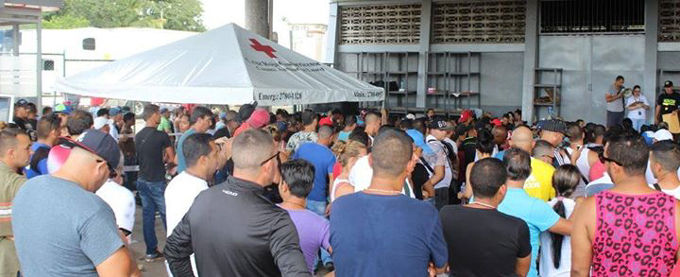
Cuban migrants in Costa Rica: ‘Looking for new opportunities’
For the past several days, more than 1,000 Cubans have been in Costa Rica, intending to travel to the United States. After they were violently barred from crossing the border into Nicaragua, most of them were placed in temporary shelters provided by the Costa Rican government, with the assistance of the local Red Cross.
So far, no casualties have been reported, although some migrants have complained of allergic reactions to the tear gas fired at them by Nicaraguan troops when they barred the Cubans from their territory.
The person contacted by Progreso Semanal resided in Ecuador for 11 months. From there, she traveled by land with a group to Colombia; thence on a boat to Panama. From there, they traveled to Panama City in small planes made available for a fee by the Panamanian government.
They arrived at Canoas Pass, on the border with Costa Rica, and were given a temporary visa to travel to Peñas Blancas, on the border with Nicaragua, where they are now (Nov. 17).
By request of our source, we are not publishing audios or revealing information that might identify her. Her testimony follows.
—-
Mario Vallejo, the Univisión reporter, was here not long ago and told us that there’s a possibility that a ship can carry us to Honduras, so as not to go through Nicaraguan territory, because the Nicaraguan government doesn’t want to let us in.
There’s about 400 people here; the rest have been sent to shelters. Some of us here have refused to go to shelters because we want to maintain some pressure. We don’t want to be forgotten.
The Immigration Service has installed showers in the park where we are and the Red Cross is taking care of us. They have fed us and are providing the necessary medical attention.
We are now in the Emigration Section facilities, where they check the passports of people who want to enter Nicaragua. It’s about 500 yards from the Nicaraguan border.
Is there any certainty about the report of a ship, beyond what the journalist told you?
Well, he came because many of us wrote to him after he sided with us when we were in jail in — what’s the name of the place? — ah, Tapachula, and he helped some of us Cubans. He said that the idea [of a ship] is being considered. He didn’t say that it’s a solution or even that it’s going to be done that way. He just said that the possibility is being evaluated, so we don’t have to go through Nicaraguan territory.
That hasn’t come out in the press. We’re aware that [Mario Vallejo] is not an official and doesn’t have the final word. We follow other directions.
What’s the opinion of other persons with you? Have other options been evaluated?
That’s the option that has been talked about the most, because taking a plane requires a lot more effort. Besides, people don’t trust air transportation because a plane could reach an undesired destination. So that’s what we have talked about the most, because it’s the only way that we can skirt Nicaragua. Due to the incidents that occurred, we Cubans fear reprisals from the [Nicaraguan] government and police.
Are there any injured people among you? People sick, beaten up, killed?
No sick people, because the Red Cross gave them priority in its shelter. If someone has a headache or high blood pressure, the Red Cross takes care of them right away. They have a tent right here, open 24 hours a day.
There was talk about two people dead, but this morning one of the alleged dead returned [LAUGHTER] from a hospital in Nicaragua. He told us he was under custody and under surveillance, but a nurse helped him escape from the hospital.
Yes, some people were beaten up and some people experienced allergic reactions to the tear gas that was aimed at us. Some people were beaten up, but it wasn’t a big thing.
Who in Panama gave you permission to travel to Costa Rica?
In Panama, we arrived at a place called Puerto Obaldía. There, they gave us the papers necessary to carry us throughout the country. Once the documents were in order, we gave them to the Emigration Section at Panama’s national airport and traveled to Canoas Pass, on the border with Costa Rica. There, we presented our papers and received permission to travel through Costa Rica.
Now that you’re a visible group, have you thought how you’ll make the rest of the trip to the United States?
Internationally, we’re being considered a “migratory emergency situation,” and the various governments have been doing everything to let us go through their territories and preparing, logistically, for it.
That’s what they’re saying so far, to keep from slowing us down, because we’re a very large mass of people. If they held us back, or made us wait too long along the route, I think the same [disturbances] would happen as they happened just now.
I don’t want to have any problem with this, because my main dream now is to return to my homeland without any problems. We are a people, and the fact that we decided to leave Cuba doesn’t mean that we’re not Cubans or that we don’t love our homeland. Yes, we do love it, but we’re looking for new opportunities.
One hour later, our source contacted us again.
We have just been informed directly from the Foreign Ministry, from the Emigration Section, about the ship. At a press briefing just concluded, they said that we won’t go on a ship [to Honduras] but that they’ll evaluate the way in which they can take us away from here without going through Nicaragua.
(Photos: From the Facebook page of the Costa Rican Red Cross.)
Progreso Weekly authorizes the total or partial reproduction of the articles by our journalists, so long as source and author are identified.




